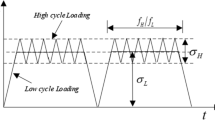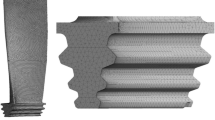Abstract
Fatigue life of the main rotor blade of a helicopter is investigated from two different approaches. The blade is comprised of many different parts such as spar, skin, abrasive strip, doublers, box beam doublers, etc. and it undergoes complex random load spectra. A finite element analysis is carried out to assess the stress distribution in the blade parts. Then, using the Miner’s rule the fatigue life of the blade is calculated following a classic life estimation method under random loading. At the next step, damage tolerance approach is used for life estimation of the blade. Fatigue crack growth properties and threshold stress intensity range of the spar is obtained based on ASTM E647 test method. Then, crack growth analysis is done using Zencrack software. In order to calculate the length of the smallest growing cracks and their fatigue crack growth life, no crack growth and slow crack growth approaches are used. A comprehensive investigation is carried out on the effect of initial crack length and aspect ratio on growth or no growth of cracks. Comparing the obtained fatigue life from two different approaches, some conclusive results are drawn.






















Similar content being viewed by others
References
Marquet T, Struzik A (1999) Damage tolerance applied on metallic components. Presented at the RTO AVT specialists’ meeting on “application of damage tolerance principles for improved airworthiness of rotorcraft”, published in RTO MP-24, held in Corfu, Greece, 21–22 April
Davies DP, Jenkins SL, Belben FR (2013) Survey of fatigue failures in helicopter components and some lessons learnt. Eng Fail Anal 32:134–151
Amura M, Aiello L, Colavita M, Paolis FD, Manuele B (2014) Failure of a helicopter main rotor blade. In: 20th European conference on fracture (ECF20), Procedia Materials Science, vol 3, pp 726–731
Wanhill RJH, Symonds N, Merati A, Pasang T, Lynch SP (2013) Five helicopter accidents with evidence of material and/or design deficiencies. Eng Fail Anal 35:133–146
Hall AD (1978) Helicopter fatigue evaluation. Helicopter fatigue: a review of current requirements and substantiation procedures. AGARD report No 674, 13–20 Sept
Guigan MJ Mc (1980) Helicopter component fatigue life determination. AGARD conference proceedings No 297, September 9-1 to 9-10
Lazzeri L, Mariani U (2009) Application of damage tolerance principles to the design of helicopters. Int J Fatigue 31:1039–1045
FAA Airworthiness Regulations (1989) Part 29, transport category helicopters, section 29.571, fatigue evaluation of structure, Federal Aviation Administration, US department of transport
Everett RA Jr (1990) A comparison of fatigue life prediction methodologies for rotorcraft. NASA technical memorandum TM 102759
Miner MA (1945) Cumulative damage in fatigue. J Appl Mech 12(1):A159–A164
Krasnowsk BR (1999) Application of damage tolerance to increase safety of helicopters in service. Dept. 81, MS. 1342, Bell helicopter Textron, Inc. BHTl
Och F (1979) Fatigue life estimation methods for helicopter structural parts. AGARD report No. 674, pp 21–27
Wolfe RA, Arden RW (1979) U.S. army helicopter fatigue requirements and substantiation procedures. AGARD report No. 674, pp 1–12
Alli P (1979) Present fatigue analysis and design of helicopter requirements and qualification procedures. AGARD report No. 674, pp 29–46
Baraniecki R, Kaniewska M (2011) Fatigue life estimation of structural element of MI-24 helicopter. J Kones Powertrain Transp 18(2):9–15
Everett RA, Elbert JW (1999) Damage tolerance issues as related to metallic rotorcraft dynamic components. Presented at the NATO/RTO spring symposium on aging systems: application of damage tolerance principles for improved airworthiness of rotorcraft, Corfu, Greece
Marquet T, Struzik A (1998) Damage tolerance applied to metallic components. In: 24th European rotorcraft forum. Marseille
Edwards PR, Darts J (1984) Standardized fatigue loading sequences for helicopter rotors (HELIX and FELIX). Part 1: background and fatigue evaluation. Royal aircraft establishment, technical report 84085
A standardised fatigue loading sequence for helicopter main rotorhead structures (Rotorix). Damage Tolerance Group Report CU/927/N/27, Cranfield University, Department of Trade and Industry Link Contract No. RA/6/30/06, (1996)
A standardised fatigue loading sequence for helicopter airframe structures (Asterix). Research Paper RP980, GKN Westland Helicopters, Department of Trade and Industry Link Contract No. RA/6/30/06
Harrison LDD, Charles C, Kanninen MF (2002) Implementation of damage tolerance concepts for metallic rotorcraft structures and drive train components. Federal Aviation Administration
Crawford CC, Carlson RL, Bates PR (1991) Damage tolerance analysis for rotorcraft: what the issues are. In: 17th European Rotorcraft Forum, Berlin, Germany, 24–26 Sept
Chan SLH, Tiong UH, Bil C, Clark G (2010) Some factors influencing damage tolerance under helicopter spectra. Proc Eng 2:1497–1504
Everett Jr RA (1999) Technical evaluation report on 1999 Specialists’ Meeting on application of damage tolerance principles for improved airworthiness of rotorcraft. Paper presented at the RTO AVT specialists’ meeting on “application of damage tolerance principles for improved airworthiness of rotorcraft”, published in RTO MP-24 and held in Corfu, Greece, pp 21–22
Forth, SC, Everett RA, Newman JA (2002) A novel approach to rotorcraft damage tolerance. In: 6th Joint FAA/DoD/NASA Aging Aircraft Conference—16–19 Sept
Lincoln JW, Yeh HC (1999) Treatment of high-cycle vibratory stress in rotorcraft damage tolerance design. Presented at the RTO AVT Specialists’ Meeting
Everett Jr RA, Elber W (1999) The significance of small cracks in fatigue design concepts as related to rotorcraft metallic dynamic components presented at the RTO AVT specialists’ meeting on “application of damage tolerance principles for improved airworthiness of rotorcraft”, published in RTO MP-24, held in Corfu, Greece, 21–22 April
Shaniavski AA (2004) Scale levels for fatigue fracture mechanisms of in-service crack growth in longerons of helicopter rotor blades. Int J Fract 128:17–24
Cook R, Wood PC, Jenkins S, Matthew D, Irving P, Austen I, Buller R (1999) The development of a robust crack growth model for rotorcraft metallic structure. Presented at the RTO AVT specialists’ meeting on “application of damage tolerance principles for improved airworthiness of rotorcraft”, published in RTO MP-24, held in Corfu, Greece, 21–22 April
Forth S., Le D, Turnberg J (2005) An evaluation of the applicability of damage tolerance to dynamic systems. Submitted to the 8th Joint NASA/FAA/DOD aging aircraft conference, Palm Springs, California, USA, 31 Jan–3 Feb
Citarella R, Apicella A (2006) Advanced design concepts and maintenance by integrated risk evaluation for aerostructures. Struct Durab Health Monit 2(3):183–196
Giglio M, Beretta S, Mariani U, Ratti G (2010) Defect tolerance assessment of a helicopter component subjected to multiaxial load. Eng Fract Mech 77:2479–2490
Mariani U, Vicario M (2004) Application of flaw tolerance methodologies to rotorcraft fatigue qualification. Agusta Westland a finmeccanica company cascina costa di camarate, Italy
Adams DO (2000) Flaw tolerant safe-life methodology. MS S346A4, Sikorsky Aircraft Corporation, 6900 Main Street, P.O. Box 9729, Stratford, CT 06497.9129, USA
Matthew D (1999) Application of damage tolerance to the EH101 airframe. Presented at the RTO AVT specialists’ meeting on “application of damage tolerance principles for improved airworthiness of rotorcraft”, published in RTO MP-24, held in Corfu, Greece, 21–22 April
US army material command (1974) Engineering design handbook, Helicopter engineering, part one: preliminary design (Helicopter engineering AMCP 706-201, preliminary design). August
Fatemi A, Plaseied A, Khosrovaneh AK, Tanner D (2005) Application of bi-linear log–log S–N model to strain-controlled fatigue data of aluminum alloys and its effect on life predictions. Int J Fatigue 27:1040–1050
Stephens RI, Fatemi A, Stephens RR, Fuchs HO (2001) Metal fatigue in engineering. Wiley, New York
User manual for Zencrack 7.5, Zentech International Ltd
Citarella R, Lepore M, Maligno A, Shlyannikov V (2015) FEM simulation of a crack propagation in a round bar under combined tension and torsion fatigue loading. Frattura ed Integrità Strutturale 31:138–147
Maligno AR, Citarella R, Silberschmidt VV, Soutis C (2015) Assessment of structural integrity of subsea wellhead system: analytical and numerical study. Frattura ed Integrità Strutturale 31:97–119
ASTM E647-13ae1 (2013) Standard test method for measurement of fatigue crack growth rates. Annual Book of ASTM standards, vol 03.01, American Society for Testing and Materials
Farahmand B (2006).Analytical method of generating da/dN curves for aerospace alloys. In: Proceedings of the 16th European conference of fracture, Alexandroupolis, Greece, 3–7 July
Hillberry BM, Alzos WX, Skat ACJ (1975) The fatigue crack propagation delay behavior in 2024-T3 aluminum alloy due to single overload/underload sequence. School of mechanical engineering Purdue university, west lafayette, Indiana
Author information
Authors and Affiliations
Corresponding author
Rights and permissions
About this article
Cite this article
Shahani, A.R., Mohammadi, S. Damage tolerance and classic fatigue life prediction of a helicopter main rotor blade. Meccanica 51, 1869–1886 (2016). https://doi.org/10.1007/s11012-015-0339-1
Received:
Accepted:
Published:
Issue Date:
DOI: https://doi.org/10.1007/s11012-015-0339-1




